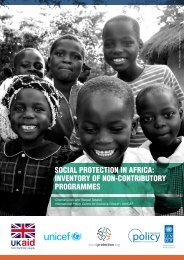https://goo.gl/sZ7V7x
293g79C
293g79C
Create successful ePaper yourself
Turn your PDF publications into a flip-book with our unique Google optimized e-Paper software.
Home-Grown School Feeding and Health Programme (HGSFHP)<br />
Programme<br />
Country<br />
Geographic area<br />
Previous programme name (if any)<br />
Home-Grown School Feeding and Health Programme (HGSFHP)<br />
Nigeria<br />
Start date 2005 1<br />
Programme objectives<br />
Programme type<br />
Programme components<br />
Sub-Saharan Africa<br />
To reduce hunger and malnutrition among school children,<br />
and increase school enrolment, attendance and retention. 1<br />
Conditional in-kind transfer<br />
The programme also includes procurement<br />
of food from smallholder farmers as a component. 1<br />
School attendance<br />
Conditionalities (if any)<br />
Targeting methods Geographical and categorical targeting. 2<br />
Target areas<br />
Target groups<br />
Eligibility criteria<br />
Eligibility reassessment (if any)<br />
Type of benefits<br />
Amount of benefits<br />
The pilot phase comprised 12 states in the six geopolitical zones:<br />
Bauchi, Edo, Enugu, Federal Capital Territory (FCT), Imo, Kano,<br />
Kogi, Nassarawa, Niger, Ogun, Yobe and Osun States. 1<br />
Children<br />
School enrolment<br />
Food<br />
The food is usually delivered in the form of a hot meal at lunch, which is<br />
designed to be balanced and to contain one third of the Recommended<br />
Dietary Allowance of nutrients. In Osun, a beverage (of milk, sugar and<br />
cocoa) is also served as a complement. 3<br />
Payment/delivery frequency Daily 4<br />
Benefit delivery mechanism<br />
Feeding takes place in dining rooms/halls at schools,<br />
where the meals are served under the supervision of teachers. 4<br />
Benefit recipients<br />
Students<br />
Minimum and maximum<br />
duration of benefits (if any)<br />
Coverage 155,000 beneficiaries, or 1 per cent of children attending school. 2<br />
Programme expenditure<br />
NGN2.9 billion has been spent on feeding,<br />
deworming, equipment and materials up to 2010. 1<br />
Institutions and agencies involved The Federal Government of Nigeria; New Partnership for African<br />
Development (NEPAD); World Food Programme (WFP); UNICEF 1<br />
Monitoring and evaluation<br />
mechanisms and frequency<br />
Inspection and monitoring is to be done using standardised checklists<br />
and schedules. This falls under the responsibilities of the monitoring<br />
and evaluation committees and other relevant agencies at all levels and<br />
led by the Inspectorate. 4<br />
See the references on page 186: Home-Grown School Feeding and Health Programme (HGSFHP)<br />
Social Protection in Africa: inventory of non-contributory programmes | 113



